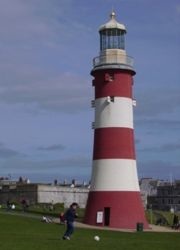


Plymouth is the largest city in the Devon county in the South-West of the England. It is a City that is situated between the mouths of the rivers Plym and Tamar. Population is estimed to be 246 100 people in 2005. This City is one of Europe's largest natural harbours.
Plymouth has a rich maritime past and is one of the most important Royal Navy bases in the United Kingdom, which made it a prime target of the Luftwaffe during World War II. After extensive destruction during the Blitz of 1941, Plymouth was rebuilt under the guidance of masterplanner Sir Patrick Abercrombie. It is still home to the largest operational naval base in Western Europe.
There are some sites to visit like the Royal Citadel, Devonport Royal Dockyard, the Aquarium, the Hoe and The Barbicane, sites where the New World emigrants left from in 1620
University of Plymouth with over 30,000 students and is the fifth largest UK university based on student populations
At the beginning, Plymouth was a fishing village which belonged to Augustinian priory at Plymton. In the thirteenth century, it was a market village. In those days, everybody went to the market to sell and buying because there was only few shops. Once the market was in Plymouth, traders and artisans came living and working in; so Plymouth grew from a village into a town which later evolved into a city.

In 1254 Plymouth received a charter giving people some rights.
Plymouth has played an important role in many wars against France in the Early History. Because of its proximity with it, Plymouth was attacked by French soldiers several times.
The worst attack arose in August 1403.
After sailling across the Manche, French warriors landed north of the city, went in it and occupied the area around Exeter Street. Despite their defence, the English failed to expel the French, who spent a whole night inside.
The next day, French warriors broke camp after having burned a large part of the city built mostly with buildings made of wood and thatch. Thereafter, this part of the city was called the Breton Side. After the disaster Plymouth was quickly rebuilt and would begin to prosper.
While the sixteenth century, Plymouth was the home port for a number of successes at sea.

The historic port of Sutton Harbour, located in The Barbican, has seen the arrival and departure of many notable people; for example Catherine of Aragon and Pocahontas arrived here in England in 1501 and 1616 respectively.
Plymouth Hoe, meaning high place, is a wide grass meadow at the top cliffs overlooking the natural harbour of Plymouth Sound. According to an enduring national myth, this is the place where Sir Francis Drake insisted on completing his game of bowls to allow wind and tide to change in his favour enabling his defeat of the Spanish Armada in 1588.
Plymouth is also internationally renowned as the departure point of the Mayflower in 1620, aboard which the Pilgrim Fathers set sail for the New World, thereby establishing the modern English-speaking constitution of the United States of America.
Their settlement of Plymouth, Massachusetts also bears the name of its European forebear.
During the English Civil War Plymouth sided with the Parliamentarians and so was isolated from the surrounding regions of Devon and Cornwall which were held by Royalist sympathisers. The town was besieged for almost four years until the Royalists were defeated. Various skirmishes and confrontations occurred, including the battle of St Budeaux and the rout of Royalist cavalry along Lipson Ridge. Freedom Fields Park still commemorates the latter site.
Construction of the Royal Citadel began in 1665, after the Restoration; it was armed with cannon facing both out to sea and into the town, rumoured to be a reminder to residents not to oppose the Crown
The dockyards at Devonport at the mouth of the Tamar, were founded in 1689 by King William III thereby establishing the naval service economy which later came to dominate the city.

Until World War II, the port at Millbay Docks was used for Transatlantic liner shipping, as it had been since the 1870s. Many of the surviving crew of the RMS Titanic disaster disembarked at Millbay docks on their return to England in 1912.
Due to its strategic proximity to the northern coast of France and its naval preeminence, the city was heavily blitzed by the Luftwaffe during the Second World War. Although the dockyards were the principal targets, the two main shopping centres, most of the civic buildings and over 3,700 houses were completely destroyed and more than 1,000 civilians lost their lives.
Charles Church has been left in its ruined state as a memorial to those civilians who died. On the Hoe stands a memorial to the many members of the Royal Navy from Plymouth who were killed in both World Wars.
In June 1944 Plymouth was one of the principal staging posts for the Normandy landings. General Omar Bradley and the 1st US Army embarked here for the landings at Omaha Beach and Utah Beach.

In 1945, Sir Patrick Abercrombie's unveiled the new plan for Plymouth to respond to the devastation of the city. He asked the destruction of the few buildings pre-war in town and their replacement by wide boulevards and modern aligned from east to west and linked by a wide avenue north-south (Armada Way), which connects the station The Plymouth Hoe.
City map Advice: print it because it's not free!
© 2008 - "les Ardéchois" corporation
made by zoom webdesign.™